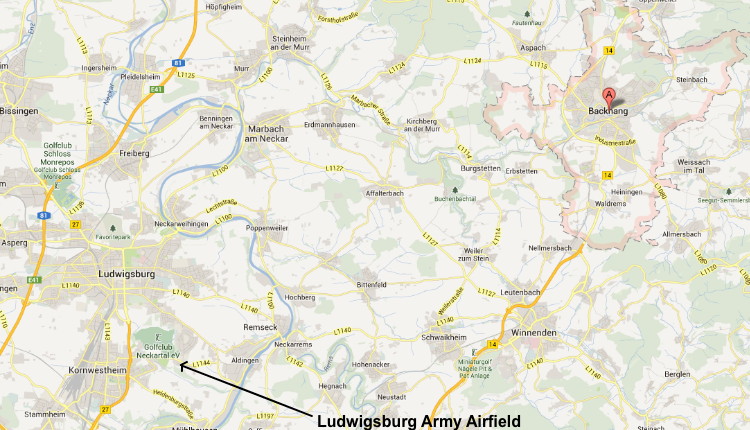AN ORIGINAL MEMBER OF THE CATKILLERS:
SP4 HARRY IRVIN KEE,
1 June 1965–July 1966
by Donald M. Ricks, CATCOM Editor
Military personnel rarely have an opportunity to totally determine their daily activities, and there is no guarantee that, by the end of the day, their lives will not be changed forever. This is especially true for those men and women who serve in aviation–related duty positions and receive hazardous duty or combat pay. In the words of the poet, Thomas Merton, “Peace demands the most heroic labor and the most difficult sacrifice.” Such is the nature and call to duty of every service member who wears a uniform. It is a dangerous job. That these undaunted and courageous men and women accept the risks and serve their country is the heroic part.
“We train hard, play hard, and try hard to be the best at what we do,” said one crew chief in Vietnam. Harry Kee served in Vietnam, too, and he seemed a modest man who would not have considered himself as anything but a soldier doing his job. Nor would most other men and women who serve their country. From what I was able to gather about him, Specialist 5 Harry Irvin Kee was just that kind of man: humble, honest, and technically capable at his job.
Harry I. Kee, Jr., entered the United States Air Force on 18 July 1950. Even before his air force days, Harry lived in Hopkins, Minnesota, and was a member of the famous (WW1, as part of the Rainbow Division) Battery C, 151st Field Artillery, Minnesota National Guard (previously at St. Paul). That unit is now located at Ortonville; thus, his basic pay entry date in army documents showed credit for that service. Here is Harry in a classic unit photo with the C Battery. At this time his family and friends referred to him as “Junior:”
Upon entry into the air force at the 5107th ASU, US Army and US Air Force Recruiting Station, Minneapolis, Harry’s initial but short basic training session began at Lackland Air Force Base, San Antonio, Texas, through July 1950. On 8 September 1950, after completing additional basic training at Sheppard Air Force Base, Wichita Falls, Texas, Harry received orders for assignment at Keesler Air Force Base, Biloxi, Mississippi. At Keesler, Harry remained at the 3390th Student Squadron, 3380th Technical Training Wing, while involved in advanced work or training with the 3380th Motor Vehicle Squadron. On 5 April 1952, orders indicated Harry had been at Scott Air Force Base (AFB), Illinois, for some time. Sometime during his service at Keesler, Captain Rupert W. Pervis, Training and Operations Officer, 3390th Student Squadron, stated the following about Harry [Air Force ranks were not changed to Airmen until a few years later than these documents. Later when that occurred Harry’s rank was Airman First Class (A1C)]:
“To: PFC Kee’s Commanding Officer, Scott Air Force Base, Bellville, Ill.
SUBJECT: Reclassification of PFC Kee, Harry I, Jr., AF27354614
This is to certify that PFC Kee’s conduct as an Airman and his willingness to work are beyond reproach; and that the military manner and maximum effort with which he carried out his assignment deserve a superior rating. PFC Kee’s civilian occupational experience, his educational background and his interest are all centered around diesel engine’s, Heavy Equipment, and the operation and maintenance of this type of machinery. It is the opinion of this Officer that PFC Kee would be of much more service to the Air Force if he were reassigned into this type work instead of the SSN. 70010 that he now holds.”
Special Orders 93, 21 November 1951, Scott AFB, directed Harry to Fort Belvoir, Virginia, for a seventy–two day temporary duty period for the purpose of attending Construction Equipment Maintenance and Repair course 5-E-12, commencing 7 December 1951. He was to return to Keesler AFB by 14 March 1952. These photos were most likely taken while at Fort Belvoir:
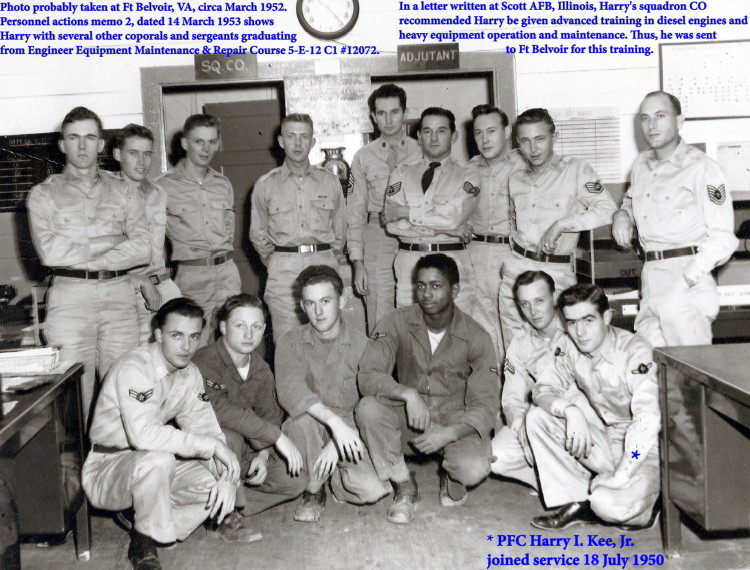
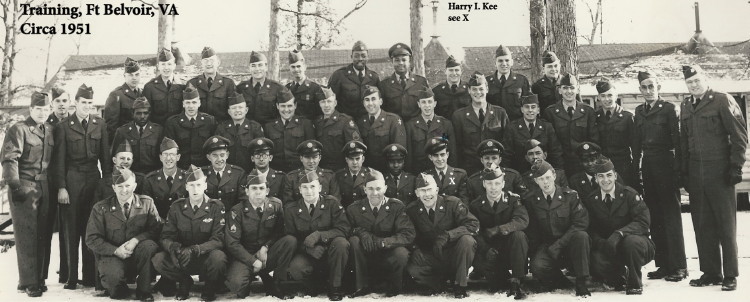
At the end of his air force service Harry decided to leave Keesler AFB and return home to Minnesota on 21 July 1954. The reason for his departure is probably contained within a last two documents from his service in the air force. A letter of commendation dated 30 October 1952 from his foreman, Wilson Sloan, Engineer Equipment Shop, Keesler, said Harry was an excellent Engineer Equipment Mechanic. The Officer in Charge of the Maintenance Shop, Captain D. A. Scofield was more laudatory and direct in his comments, “I sincerely appreciate having personnel of your caliber working for me. Mr. Sloan, your foreman, has often requested you to be considered for promotion, but unfortunately there has been few vacancies in your Specialty....” Major William B. Downey, Commander, 3380th Maintenance and Supply Group, Keesler, wrote on 17 March 1953 that he appreciated the “extra time you have spent working on you own time to expedite the movement of the five Amphibious Vehicles assigned to the Army. It is understood that most of the work accomplished was of a voluntary nature and that you expected nothing in return.” Harry did not rise above A1C and would return to civilian life and then join the army.
Germany, First Tour:
Upon entry into the United States Army, Harry Kee was trained as an Airplane Mechanic, with a secondary military occupational specialty as an Engineer Equipment Repairman. His date of rank for SP4 was 15 March 1963 while with the 11th Armored Cavalry Regiment. An enlistment record shows Harry’s basic pay entry date as 3 March 1955, so he must have has a break in service of several years before joining the army.



Photographs received from Mrs. Gerene Kee support her statement that her husband had two assignments in Germany. Close inspection of the group of excellent photographs she provided revealed that Harry’s first assignment was with Aviation Company, 11th Armored Cavalry Regiment (ACR), Straubing, Germany, from 12 November 1962 to 4 August 1964. Here, in the first photo, he is seen leaning against an Aviation Company Birddog on a snow covered ramp. In the second photo, these men wore the 7th Army shoulder patch:

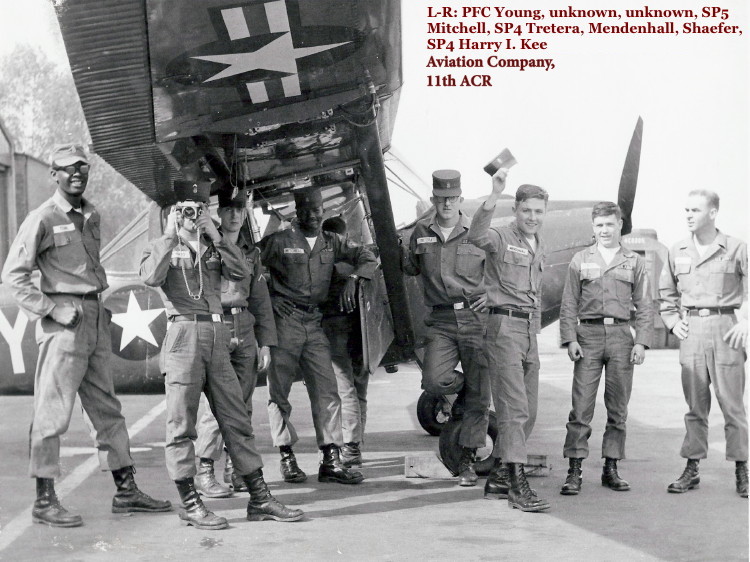
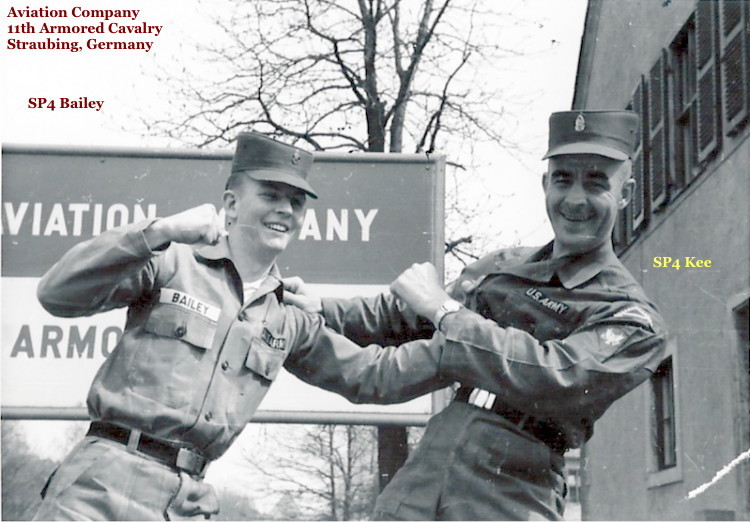
According to a history page for the 11th Armored Calvary Regiment, “In 1957, the 11th Armored Cavalry Regiment was deployed to Germany to replace the 6th Armored Cavalry Regiment patrolling the West German/Czechoslovakian border. In May of 1960 a separate Aviation Company was added to the Regiment. Also at this time, in an effort to regain a sense of historical esprit de corps within the armored cavalry regiments, the Army reestablished the nomenclature from battalions and companies to the traditional terms of squadrons and troops. The Regiment left Germany and redeployed to Fort Meade, Maryland in 1964.” Guess who also moved with the 11th ACR to Maryland?
In a ceremony in Germany, probably as his unit began to relocate to Maryland, Harry stood in line to receive some type of reward or recognition. This paragraph will change when we discover what the formation was all about (circa 1964):
This following photograph of Harry Kee has no know history except that it was taken in Germany while Harry was in the 11th ACR. The officer in this unknown recognition ceremony photo is identified by help from Tom Cousins, A Company Scout, 1st Battalion, 11th ACR, who served at Straubing from Jan 1959 through September 1960. The third photo was taken at a later or earlier date in warmer conditions:
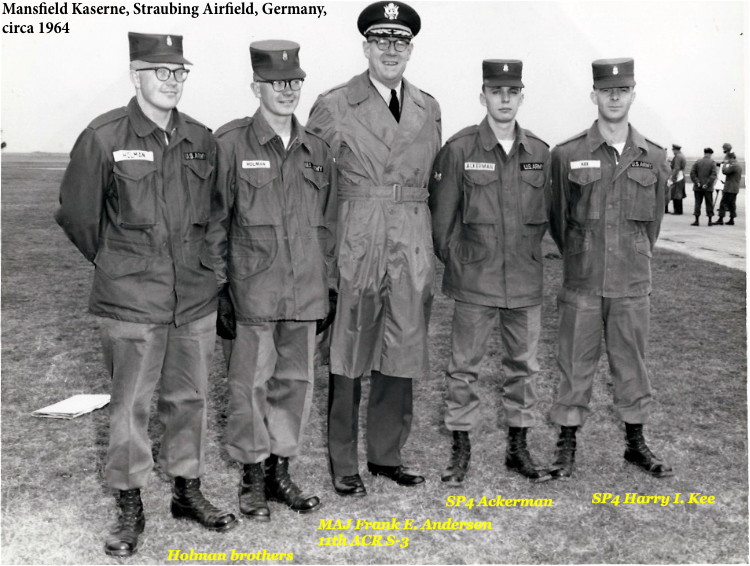

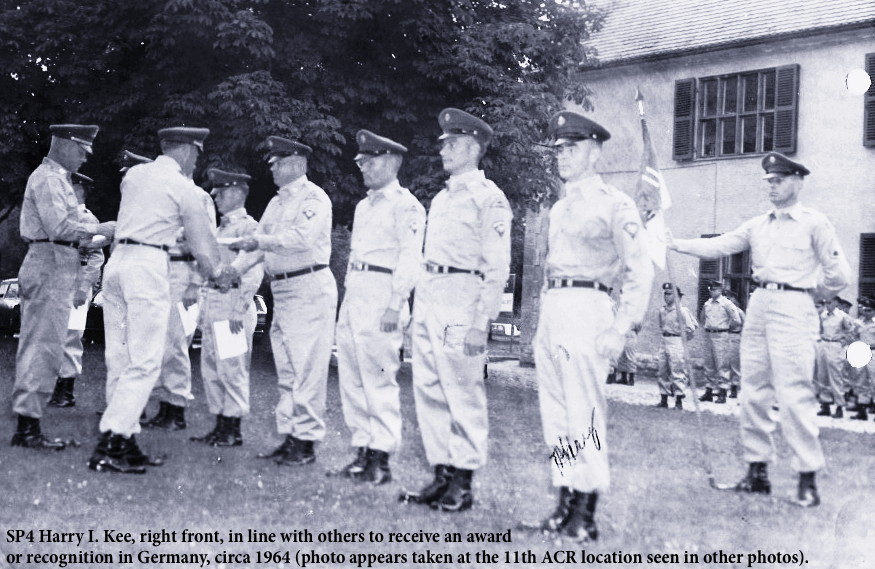
Special Orders 69, dated 27 April 1965, Headquarters, 11th ACR, Fort Meade, Maryland, shows SP4 Harry Kee, of Excelsior, Carver, Minnesota, reenlisted for his own vacancy in the Aviation Company for a period of six years. Just a few days later, on 11 May, Harry would be packing for service in Vietnam.
Vietnam:

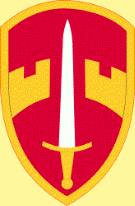
During 1965–66, Harry served with distinction in the 220th Aviation Company “Catkillers,” and specifically with the 3rd Platoon at Da Nang, South Vietnam. The information regarding his place of assignment came from his wife during an early conversation on 4 July 2013, and from a personal phone conversation with his platoon sergeant, SFC Dominick Cereccia. Dominick later came back for a second tour as the unit’s First Sergeant and was a Command Sergeant Major upon retirement. Confirmation in the form of photographs are courtesy of his wife, Gerene Kee, unless noted. By 6 June 1966, Harry was a Specialist Fifth Class, as we see in the first photographs we have of him as a Catkiller. However, in a second package of documents received from Mrs. Kee, we learn that Harry Kee and his first tour with the 11th ACR connect directly with his arrival in the 220th Aviation Company.
To explain this statement is an historical set of orders that identifies not only SP4 Harry I. Kee as an original member of the 220th Aviation Company at Fort Lewis, Washington, but also PFC Jack C. Cumbie as an original member of the 219th Aviation Company. From this set of orders we know that Harry Kee came to our unit via the return of the 11th Armored Cavalry Regiment to Fort George Meade, Maryland, and then as shown below. Further research might provide more details—but the document gave Harry Kee and Jack Cumbie only a three days notice before their “WP” (will proceed) date:

Special Order 78 instructed Harry to report not later than 1 June 1965. It also verified the guarded nature of the assignment and with guidance that the unit would further deploy overseas. He was not allowed to take his dependents to Fort Lewis, for obvious reasons. Eighteen days later the Advanced Party of the 220th Aviation Company would board air force transport planes and depart McChord AFB, Washington, headed for Vietnam. Captain Bill Schmale, SP4 Kee and the rest of the company would arrive at Da Nang in the early morning hours of 4 July 1965.
On 7 August 1965, Major General Lewis W. Walt USMC, assumed his new responsibility as senior advisor, and Colonel Howard B. St. Clair, USA, the former senior advisor, became his deputy at the Marine I Corps Advisor Team.
“The largest number of Marines serving as advisors to the Vietnamese were assigned to the MACV I Corps advisory organization. General Walt, as senior advisor for I Corps, had overall responsibility for the U.S. advisory program in the five northern provinces. The advisory effort was entirely separated from III MAF and, in fact, was administered by the I Corps deputy advisor, an Army colonel, Colonel Howard B. St. Clair. Colonel St Clair served in this capacity until relieved on 1 March 1966 by Colonel Archelaus S. Hamblen, Jr..” Source: Chapter 20, PART VIII, THE SLF, ADVISORS, OTHER MARINE ACTIVITIES, AND A FINAL LOOK AT 1966
Although the exact presentation date is not known, it probably occurred before 1 March 1966. As we fast–forward six months with two photographs, Harry Kee receives the Crew Chief of the Month Award from Colonel Howard B. St. Clair. While there might have been other reasons for a visit Colonel St. Clair was a very high ranking officer to present such an award in the Catkiller organization. The significance of these first photographs became even less clear with receipt of a few letters from officers above the platoon level also arrived in the second set of materials sent from Mrs. Kee.
Initially, the next higher headquarters for the 220th Aviation Company was the 14th Aviation Battalion, 12th Aviation Group. What is not clear in these next two documents is why the battalion commander send a letter of commendation for an award presented several months previously by the commander of the 220th, Major Curry and possible Colonel St. Clair:
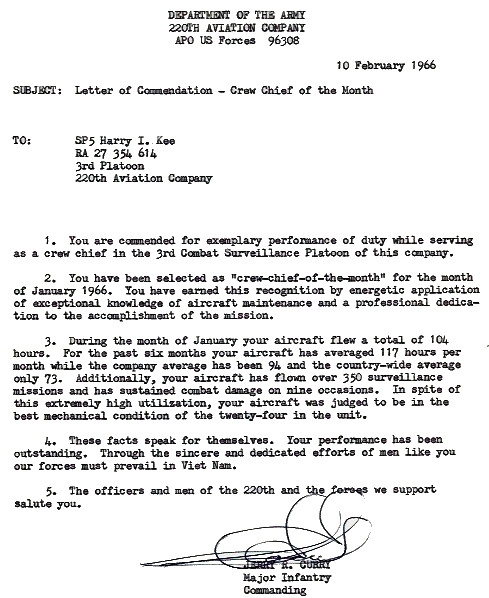
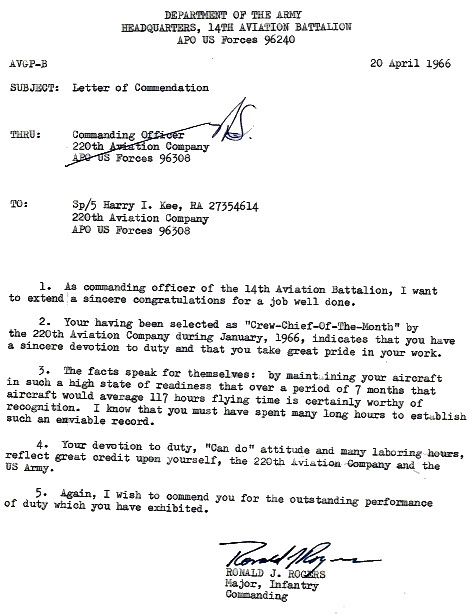
Colonel Howard B. St. Clair, USMA ’39, passed away on July 2, 2003. The letter from Major Curry identifies the 3rd Platoon as: 3rd Combat Surveillance Platoon, 220th Aviation Company.
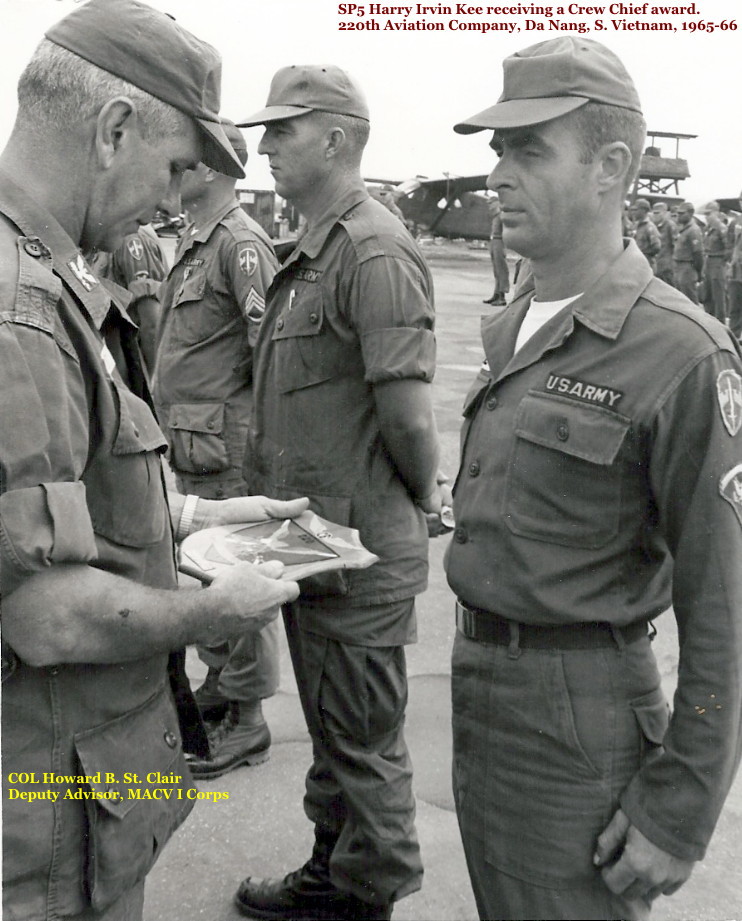
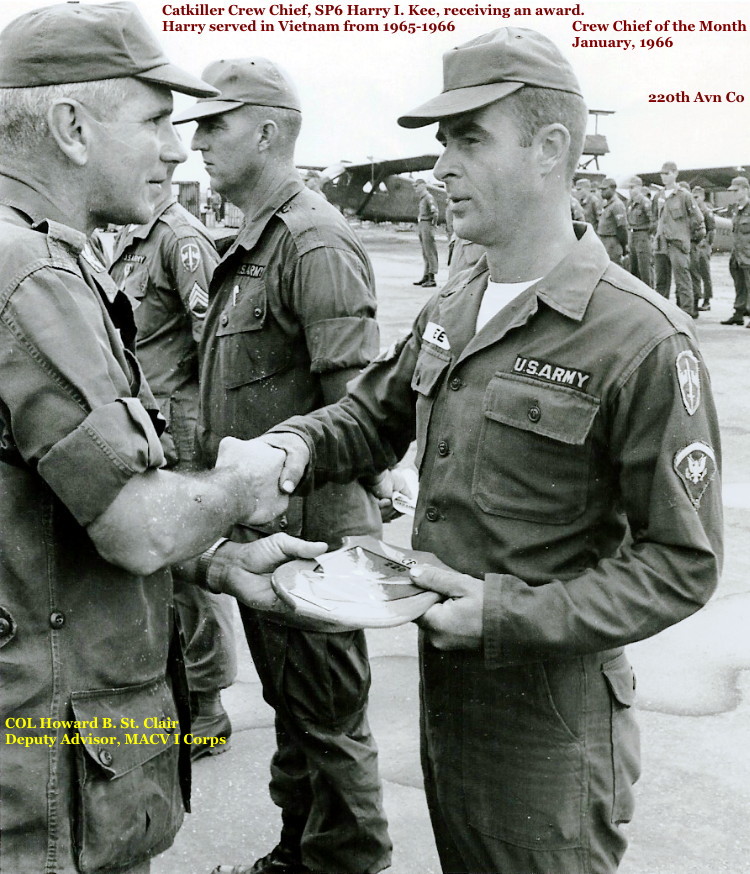
PHOTO CAPTION: CHASKAN [newspaper in Minn.] IS CREW CHIEF OF MONTH IN VIETNAM! Army Specialist Five Harry I. Kee, 33, right, whose wife, the former Gerene Bongard, lives in rural Chaska, is pictured above receiving the Crew Chief of the Month Award February 13 in Vietnam from Colonel Howard B. St. Clair, senior U. S. Army advisor, I Corps, Republic of Vietnam. A crew chief is responsible for the maintenance of aircraft and although Specialist Kee's aircraft averages 117 flying hours per month, 23 hours above the company average, his aircraft was judged in better condition than all others. Kee, assigned to the 220th Aviation Company in Vietnam, entered the Army in July 1962. The 1948 graduate of Marion (Iowa) high school, Specialist Kee was associated with Kee Excavating, Excelsior, before entering the army. (US Army Photo)
Research Note: SEA TIGER was the weekly news paper for III MAF (Marine Amphibious Force) in Vietnam. The newspaper got its name from the Vietnamese words, “Cop Bien,” which mean, “the Marines who came ashore from the sea to fight like tigers on their shores.” The first issue was published on 10 November 1965 and the last issue on 14 April 1971.
The 220th Aviation Company Maintenance Technician for the period of this article was CW2 Donovan E. Behny. Mister Behny was as meticulous record keeper, and in fact the maintenance record located in a maintenance office desk by Captain Paul Garin, 1970–71, was his initiative. During July 2013, I received several identical hand–written pages from the book included in a package of information received, and Mister Behny confirmed that he had started and maintained that book while assigned to the 220th. In addition to those pages were platoon rosters from the three active platoons present in the company at that time. There was also a list of men who received the Crew Chief of the Month award, by aircraft, during a six month period from December 1965 through May 1966:
- Dec 1965: 57-2956, SP5 Ward, 2nd Platoon
- Jan 1966: 55-4657, SP5 Kee, 3rd Platoon
- Feb 1966: 57-2939, SP4 Hubbard, 2nd Platoon
- Mar 1966: 57-2957, SP4 Vegoren, 1st Platoon
- Apr 1966: 57-2785, SP4 D. Blades, 2nd Platoon [Of the 2nd Plat. Blades twins, both had initials W. D. B.]
- May 1966: 57-2953, SP4 Bradley, 3rd Platoon
Recently received photographs of Harry Kee in Vietnam, courtesy of his platoon mate, SP4 Joseph Clark Kemper, who was in the 220th during the same period:


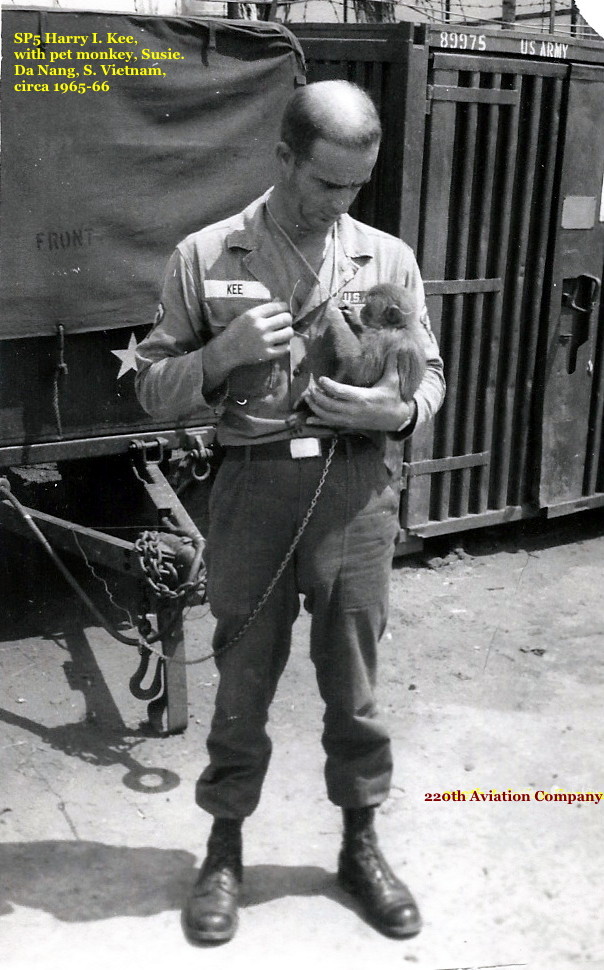
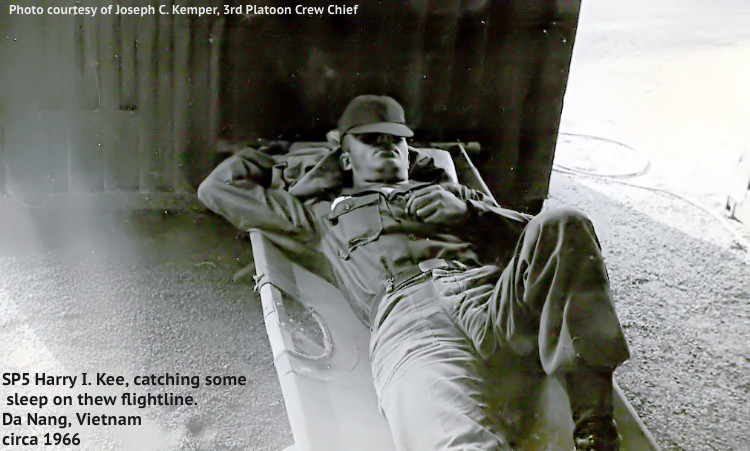

Joseph Clark Kemper, Catkiller Crew Chief 1965–66, sent in several sets of orders that helped add many names to the unit’s web roster. Many of the 3rd Platoon men identified in the photos above appear on those orders. SP5 Harry Kee and eight others from the 220th received authorization for a monthly cost–of–living allowance of $2.57, effective 8 December 1965. Another official record available to establish his service with the Catkillers comes from Unit Order 28, which references Marine Corps Bulletin 1650, dated 29 April 1966. That order awarded SP5 Harry I. Kee and forty-three others the Navy Unit Commendation Ribbon Bar, for service with the 1st or 3rd Platoons, 220th Aviation Company, during period 18–23 August 1965. Mrs. Kee mentioned that Harry had served a total of thirteen months in Vietnam and was then transferred to Germany. Harry later received the aforementioned award at his unit in Germany.
Germany, Second Tour:

In Germany, Harry was assigned to the Aviation Section, 540th Engineer Group, with duty station at Ludwigsburg Army Airfield, the present Pattonville Airport (EDTQ). For reference, Backnang Heiningen Airfield, Baden–Württemberg, Germany, is located 11.1 miles east, and Stuttgart-Echterdingen Airport is 12.1 miles south.
Shortly after his arrival, an award for his Vietnam service during the period 18–23 August 1965 finally caught up with this soldier for presentation. It is through his excellent personal record keeping that we have the full version of the Navy Unit Commendation Citation forwarded to his unit from Headquarters, Department of the Army, Office of the Adjutant General, dated 21 March 1967. Accompanying the citation and attached was the original Unit Order 28 available atop the Catkiller web roster. Even though his first name was incorrectly shown on the forwarded document as Harvey the award found its way to his assigned unit. The three–page document is available for separate viewing from the links below:
For participation in Operation Starlight (1965)
Navy Unit Commendation citation, 7th Regimental Landing Team, page2
Navy Unit Commendation citation, 7th Regimental Landing Team, page3
A Department of the Army Certificate of Training, dated 24 April 1967–18 May 1967, certified that Specialist 6 Harry I. Kee, Headquarters and Headquarters Company, 540th Engineer Group, successfully completed the USAAVCOM CH–34 Helicopter/Field Maintenance Course given at the United States Army Aviation Maintenance Center, Sandhofen, Germany. Although now working closely with rotary wing aircraft and gaining respect working on a work–horse machine, Harry would also maintain a close association with fixed wing aircraft through the local flying club.
SP6 Harry I. Kee was “well respected, the most knowledgeable, sought–after senior crew chief,” according to one of the pilots with whom Harry first flew that day, CW2 Neil M. Weems. In fact, they often flew together as Mister Weems sought out Harry to fly on his aircraft during missions and, he adds, “Everyone had the utmost respect from Specialist Kee and everyone wanted him to be working on his aircraft. He was the go-to guy who had the knowledge and the maturity and the expertise, and I swear he was a comfort to have on board.”
In early 1968, Harry obviously applied for warrant status, as an endorsementdated 11 January 1968 from his unit commander, 2LT Norman D. Lamar, Jr., has these written comments:
“In the time I have known SP6 Kee he has proven to be a very competent and honorable individual. His knowledge of his job and military subjects have been a definite asset to the unit. SP6 Kee has been assigned to the Aviation section of the 540th Engineer Group since 1 September 1966. In that time his knowledge and untiring efforts have proven very valuable in keeping our aircraft flying. He has spent many extra hours in the shop so that the aviation mission could be carried out with minimum delays. The age and number of our aircraft makes his job a difficult one. We do not have enough aviation personnel on hand for the amount of aircraft we have, yet there is never a word of complaint from this man. He is a civilian pilot of no mean ability, adding to his qualifications. I feel that no additional schooling is necessary to qualify this man for the warrant he seeks. I would be happy to have him in my command at any time.”
It was 25 January 1968, a cold, snowy season in the Stuttgart military community area and that day would also be foggy. Harry and three other brave men would follow orders and do their best to accomplish the mission, something that is done willingly, every day, in all parts of the world in which our service men and women serve.
Harry traveled from his home in the housing area at Pattonville’s military housing area, Ludwigsburg, to the airport just south of Pattonville’s housing and high school areas. Captain Randy Ranels, the group adjutant for the 540th Engineer Group but previously assigned to the aviation section, was asked to take a mission to assist in the recovery of an aviation section aircraft stranded in a REFORGER maneuver area not far from home base. He and CW2 Weems were to fly a CH-34 helicopter to that location and return as a flight of two with the helicopter that had been left at the field location when the unit moved back to its base camp. They were to accomplish the mission with Harry Kee and another unidentified crew chief onboard.
Upon arrival at the field recovery location, Captain Ranels accepted the recovery CH–34’s one–time circle red X condition for a malfunctioning attitude indicator, bad radios and unreliable navigational aids. It seemed a logical and reasonable personal decision to ask CW2 Weems, the more recently experienced aviator, to take charge and lead the return flight in the better of the two aircraft.
In another reasonable decision, CW2 Weems knew both available crew chiefs well and instructed SP6 Kee, the more senior and experienced of the two, to accompany Captain Ranels in the second aircraft, in case his pilot should need his technical experience. Harry Kee dutifully climbed aboard the second helicopter and took the left seat.
Accident at Banknang—1968:
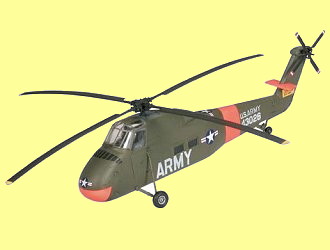
Upon departure, they maneuvered at low altitude along a route in snowy and low ceiling conditions. Both pilots knew it was hilly along the route. The lead stated he never once went IFR; he always remained clear of clouds along the route and at the altitude flown back to base. He felt very comfortable and was talking with CPT Ranels in the following aircraft. Two thirds of the way back home, inflight contact was lost. It was impossible for the lead aircraft to turn around since he did’t have the ceiling to do so. Thus he proceeded onward to home base. After landing at Ludwigsburg Airport, CW2 Weems was informed there had been a crash.
There were only two men aboard the helicopter flown by Captain Ranels and very few specifics about the crash survive the years and the loss of recollection caused by the accident. Since the aircraft impacted on its left side, and SP6 Harry I. Kee occupied the left seat, he suffered severe injuries and died. Captain Ranels was severely injured, too, but would regain consciousness after a few days in a German hospital in Banknang near the crash site.
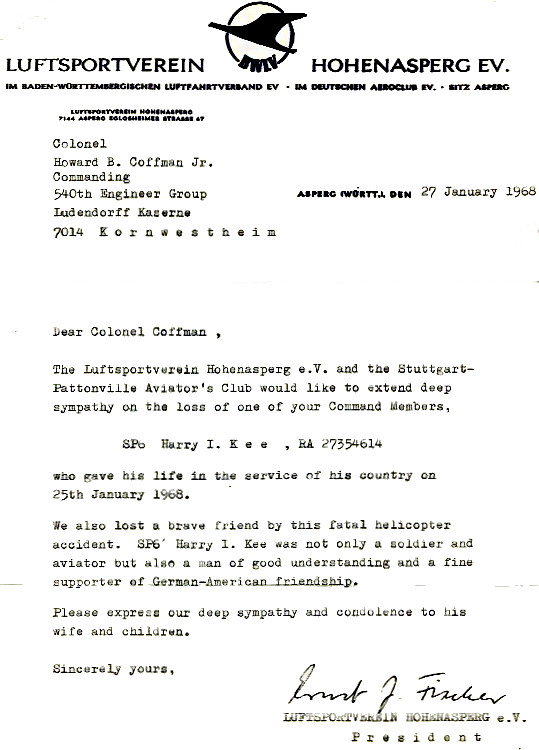
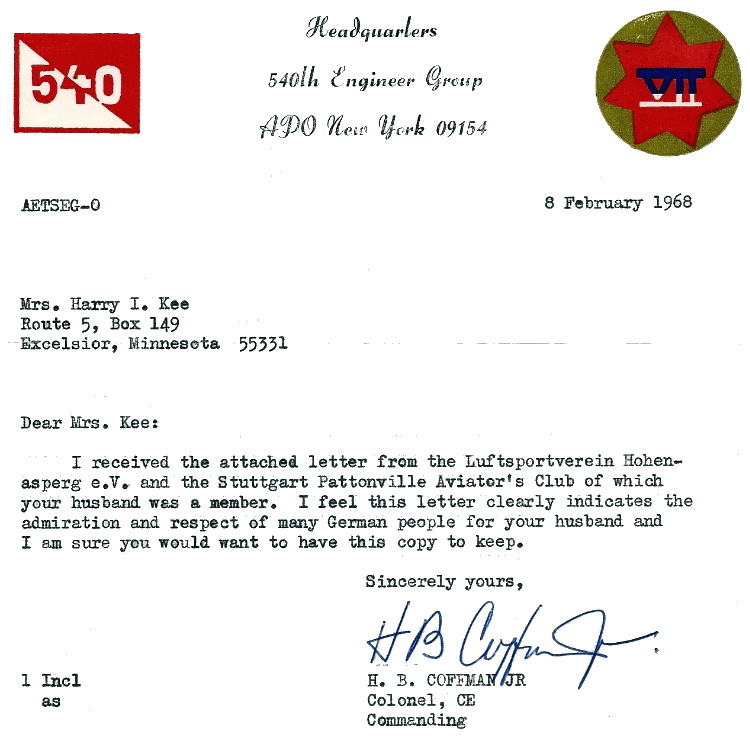
Editor’s Note: This writer has also flown in that same area in UH–1 helicopters, being stationed with the 25th Aviation Company (Corps) “Wings of the Jayhawk,” located at Stuttgart Army Airfield, Echterdingen, West Germany, in 1980–83. We also flew C-12 and U-21 airplanes. Terrain and weather conditions vary, and it can take only a few seconds for a situation to progress from poor to critical, especially in snowy conditions with no visible points of ground reference. Too, these aviators were flying single pilot when the accident occurred, a configuration we were not allowed to have in helicopters during my tour. Thus, they had to both fly and navigate in marginal weather conditions.
Epilogue:
Captain Ranels spent eleven months in hospitals recovering from extensive injuries and does not recall much about the actual accident. He adds, “I was in a body cast at Landsthul for two months before being medivaced to William Beaumont Army Medical Center (WBAMC) in El Paso, Texas, instead of Randolph AFB’s burn-patient clinic. I was not burned but had extensive scarring on my face, hands and legs, left–lung collapsed.”
After his miraculous recovery, Captain Ranels was assigned a second tour to Vietnam as a Cobra Instructor Pilot/Standardization Instructor Pilot with the AH–1 United States Army Vietnam (USARV) Training Team. Upon return from Vietnam and check–in at Davison Army Airfield, Fort Belvoir, Virginia, the flight surgeon concluded he should never have flown again (unconscious more than twenty–four hours). However, for continued flying status, the army issued a waiver from the Surgeon General, and Randy continued to fly with the 2nd Brigade Combat Team, 1st Cavalry Division based at Fort Hood, Texas, and with 2nd Squadron, 17th Calvary Regiment, based at Fort Campbell, Kentucky. With limited profiles, MAJ Edwin R. Ranels switched to Research and Development and worked at the United States Army Armament Research and Development Command for the last seven years of his military career and retired as a Lieutenant Colonel.
During 1965–66, CW2 Weems served a tour at Fort Benning , Georgia, with B Troop, 1st Squadron, 9th Cavalry, 1st Air Cavalry Division, and then moved with that unit to Vietnam. He then served a tour in Germany as an aviator with the Aviation Section, 540th Engineer Group, 1967–68. In February 1968, he accepted a direct commission as a second lieutenant. He returned to Vietnam to serve a second tour as Fire Team Leader, Company B, 25th Aviation Battalion, 25th Infantry Division, 1968–69, during which he was awarded the Silver Star and Distinguished Flying Cross. He served with distinction through several successive staff and command positions from company to battalion level and then attended the Command and General Staff College in 1980–81. During his last tour before retiring after twenty–nine years of active service, LTC Neil Weems served as Deputy Commander, 2d Signal School Brigade, Fort Gordon, Georgia, 1988–1989.
Though the task was surely a very difficult one under the circumstances, CW2 Neil Weems and the Chaplain were the officials who informed Gerene Kee that her husband had been killed in the helicopter crash. Mrs. Kee states that at the time the oldest of her seven children was about thirteen years old. She and her family were told they were allowed to remain in government quarters for several months but she soon returned to her home state of Minnesota to purchase a home.
The remains of Harry Irvin Kee were flown to Minneapolis International Airport on 30 January 1968 aboard Flight 235, Northwest Airlines, and escorted by a member of his unit, SFC James F. Ehmer. Harry was interred at Fort Snelling National Cemetery, Minneapolis, Hennepin County, Minnesota, on 2 February 1968. Mrs. Gerene Kee set about her main task of taking on the biggest job she has ever had: raising her seven children. She still owns the same home today that she purchased in 1968 and has raised her seven children in the same community. She worked through the challenges faced each day to educate, clothe and nurture those children. All are successful in their chosen fields of business or health care and have given Gerene justification for her faithful work. She rightfully claims to be a proud mother; you can hear it in her voice and sense it in her manner of speaking.
Well done, Gerene Kee!
COMMENTS:
Yes, I do remember Harry Kee and have a photo of Harry in a boat while we were water skiing the Han River In Da Nang (some folks don’t believe me about the water skiing story). I remember Harry as being a quiet guy; I respected him greatly. Looks like this [awards] photo was taken at company Headquarters, with the Beaver and the guard towers in the background, but I could be mistaken.
I don’t remember the monkey Susie, but I do remember some guys that could have qualified!
Raymond (Ray) Cluggish [Crew Chief, Da Nang. See the mentioned photo in the Vietnam section above]





